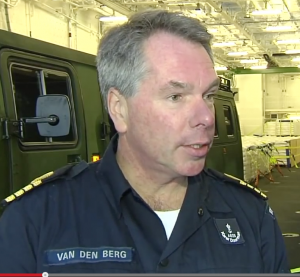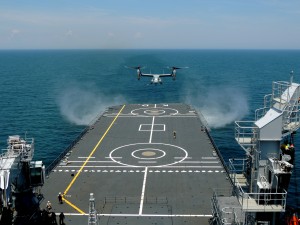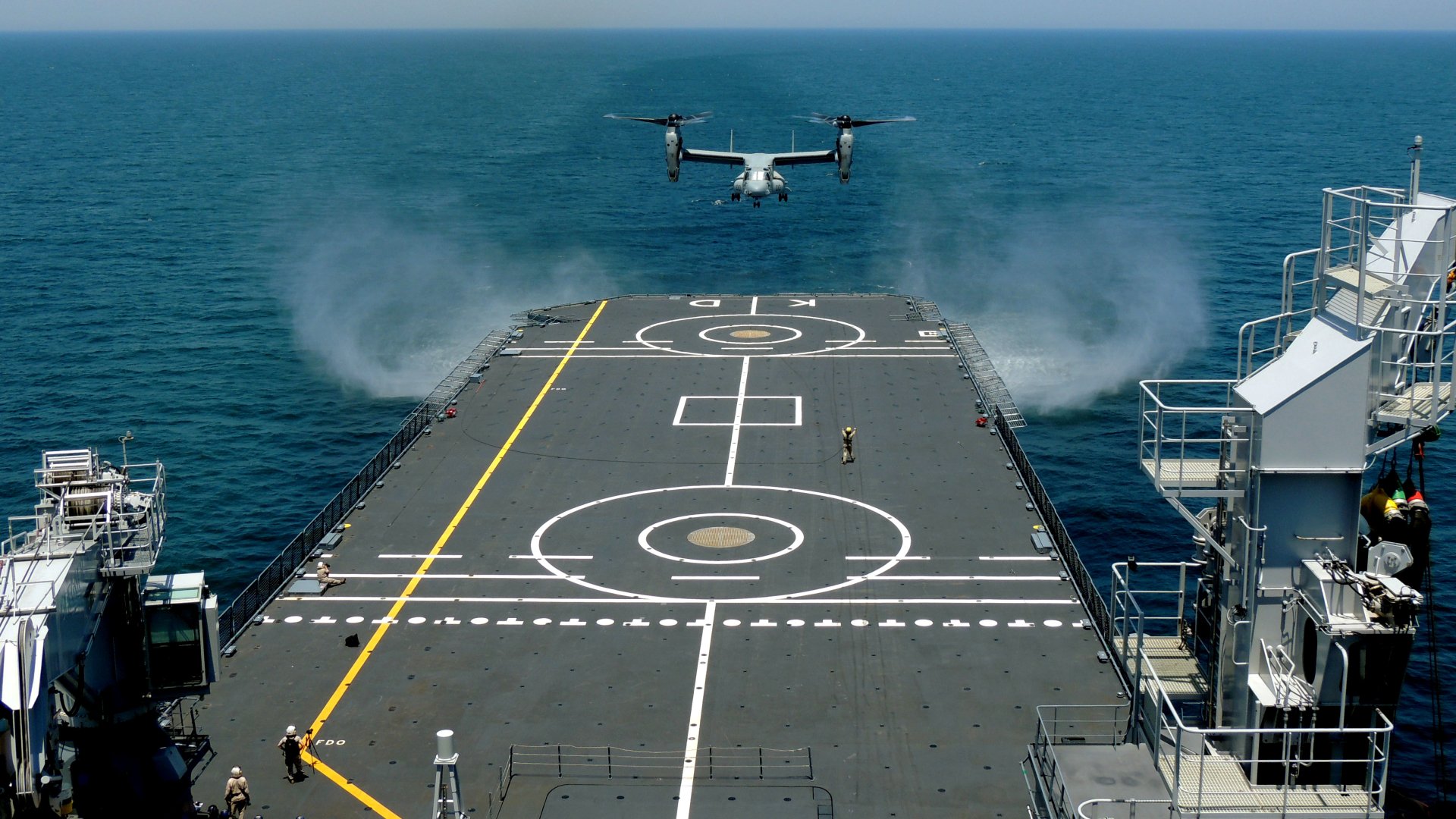I have followed the Osprey since 2005.
It has clearly been a driver of change for the USMC and the joint force.
And one key area of change became evident early on: it can land on a wide variety of ships in the U.S. or allied fleets, and thereby expand the utility of sea bases for Humanitarian and Disaster Relief Operations (HADR) or combat operations.
With the allies and partners of Indonesia building out their fleets, there will be obvious opportunities to land on and leverage those allies and partners sea bases, whether it would be with Australia (recapitalizing its Navy),with the United States (sorting out the best ways to address sea control and sea denial in the Pacific alone with SLOC defense and offense), with South Korea (building out its amphibious fleet) or with Japan (building out its amphibious fleet as well), just to mention the major players in the Pacific region.
Or put more broadly, the allies and partners are building out their fleets, and with ships on which clearly Indonesian Ospreys can land and operate.
And a key advantage of working with ships is, of course, is both operational flexibility and political agility in a crisis.
But one does not need a specialized ship for the Osprey to land on and to provide connectors for the force.
We followed closely the Bold Alligator exercises held in the last decade, and in one of those, the Osprey landed on a T-AKE supply ship.
In another exercise held off of the Carolina coast, an Osprey landing was done on a Dutch warship and then later in the year, during a NATO exercise, a second landing was conducted.
We interviewed the T-AKE captain involved in the Osprey landing as well as the Dutch Captain of the HNLS Karl Doorman, and both interviews highlighted how the Osprey expanded their ability to work with the joint or allied force.
This is a key capability which clearly rotorcraft (with more limited range and speed) or fixed wing airlifters (which require landing bases) cannot bring to the Indonesian force.
The Osprey creates a new combat or HADR capability by its range and speed and ability to land vertically on a wide range of shipping, including supply and combat ships.
Linking Coalition Warships
We published an article on Jun 22, 2015 which highlighted the evolving role of the new aircraft in working with the fleet.
We entitled the article “The Osprey as enabler: Linking Coalition Warships.”
This was a summary of efforts to that date, so Indonesia would not need to worry about buying an untested capability for fleet connectivity; it was already there mid-decade.
I argued the following in that article:
The speed and range of the Osprey is a key combat enabler.
It also provides significant reach and range to connect US and allied warships into a 21st century sea base.
The capability to provide for resupply has been demonstrated many times, but the capability delivered in Operation Odyssey Dawn whereby Ospreys flew roundtrip from the USS Kearsarge to Sigonella to resupply Harriers was a clear statement of new opportunities.
As the Osprey has become a fixture of USMC and USAF global operations, the Marines have been working operations off of foreign warships as part of the process of building out an Osprey-enabled sea base, writ large.
Among others are the UK, French, Japanese, South Korean, and now Dutch warships.
https://sldinfo.com/looking-back-usmc-ospreys-and-harriers-aboard-the-hms-illustrious/
https://sldinfo.com/the-mv-22-operates-off-the-dixmude/
https://sldinfo.com/the-osprey-globally-engaged-this-time-landing-on-a-japanese-ship-in-the-apr/
During Bold Alligator 2012, the Osprey landed on a T-AKE supply ship which expanded the lily pads from which an assault force can be launched.
The Navy is looking to expand the size of the hanger aboard the T-AKE so that an Osprey can be kept in the hanger and one on deck for a total of two as needed.
Now the two dynamics – landing on a supply ship and on a foreign warship – have been combined during training off of the East Coast of the United States with a Dutch supply ship on June 12. 2015.
In the remainder of this article, we are taking our readers back to those two experiences, the Osprey working with the T-AKE supply ship, and the USMC working with the Dutch Navy.
The Osprey and the T-AKE Ship: 2012
Second Line of Defense visited the USNS Robert E. Peary (T-AKE 5) while it was in port in Norfolk.
The ship caught our eye while we were covering Bold Alligator 2012 because of the first operational engagement of an Osprey aboard a T-AKE ship.
Captain Little is a graduate of the Merchant Marine Academy and has operated off of virtually every asset Military Sealift Command operates, since he joined in 1989.
He was the first chief mate for the T-AKE 5 when it was delivered to the Navy in 2008.
He and his crew had just returned from a 9 ½ month tour, which included action off of Libya as well as participation in the Bold Alligator 2012 exercise.
Notably, the helos, which operate off of his ship during deployments, are either USN helos, or Eurocopter Pumas.
And the ship is extremely flexible in providing supplies of various kinds, including ammunition and fuel. During the Libyan operation, the USNS Robert E. Peary worked with several allies as well.
The men and women of the Military Sealift Command are true mariners.
They operate at sea off and on during the year with only three months off.
They are civil servants but are closely intertwined in support of the warfighter.
The Role of the T-AKE Ship in Providing Forward Presence from SldInfo.com on Vimeo.
As Susan Melow, Public Affairs Officer, for MSC’s Military Sealift Fleet Support Command clarified for us:
A civil service mariner, or CIVMAR, is a federal government employee who pursues a civil service career while assigned aboard U.S. government-owned, Military Sealift Command-operated ships responsible for global fleet support.
CIVMARs are credentialed, in their areas of expertise, by the U.S. Coast Guard and are rotationally assigned to MSC ships for stints of, at a minimum, four months.
With no shore duty breaks during their civil service careers and with, generally, thirty days separating each ship assignment, CIVMARs are consummate mariners, journeymen in their fields.

SLD: Captain, could you talk a little bit about the Osprey landing on the T-AKE ship?
Captain Little: “The Osprey landing was a long range supply demonstration.
“It took off from New River, landed on our ship, got refueled and then participated in a raid on Fort Pickett more than 180 miles inland.
“The Osprey was on deck for about 30 minutes, loaded four pallets, was able to refuel, and took off with her cargo to support the Marines ashore in Fort Pickett….”
Dutch Warships and the Osprey: 2015
According to a story published by the USMC on June 16, 2015 by Lance Cpl. Fateh Saad, the first landing of an Osprey aboard a Dutch warship occurred on June 12, 2015.
MARINE CORPS AIR STATION NEW RIVER, N.C. –
Spirits ran high aboard the Karel Doorman, a warship with the Royal Netherlands Navy, as U.S. Marines with Marine Medium Tiltrotor Squadron 261 made the first MV-22 Osprey landing aboard a Dutch ship during an interoperability test conducted near Marine Corps Air Station New River, North Carolina, June 12.
“What we normally do is support the forces ashore,” said Capt. Peter van den Berg, the commanding officer of the warship.
To better support ground forces, the amphibious unit recognizes it needs aircraft support, said van den Berg.
“That’s why the Netherlands Navy is very interested in cooperating and integrating with the U.S. Marine Corps and operating the Osprey from our decks,” said van den Berg.
“The Osprey is capable of doing large airlifts at a time, instead of a smaller helicopter – an Osprey can take much more personnel back to shore.”
The landing was the first of its kind and tested the interoperability of the two military entities, as well as the Dutch’s ability to host the American aircraft aboard their ships through carrier landings.
“The majority of people live within 300 nautical miles of the ocean,” said Capt. Matthew Thompson, a Marine with VMM-261 and the pilot and operations officer for the exercise.
“With that in mind, the true Marine aspect of ‘from the sea, to the shore,” is increasingly important. Being able to land on a ship, or sea base from a ship, and move people, things, to the shore is increasingly important.”
The test included five landings aboard the warship along with a refuel check to test the Osprey’s ability to receive fuel from the Dutch warship.
“[This test] supports the mission of the 2nd Marine Aircraft Wing because when units from 2nd MAW move forward, they sometimes work in concert with coalition partners and that may include the Dutch one day,” said Thompson.
Thompson said building a stronger relationship and testing the units’ ability to integrate was the central focus of the carrier landings.
“The MV-22 Osprey provides commanders with unprecedented agility and operational reach,” said Thompson.
The U.S military has a long-standing history working with their Dutch counterparts, a partnership both units expressed an interest in deepening.
“Having the knowledge that we learned today can help us when we move forward, if we ever work with the Dutch, which I think is a very real possibility … especially when we saw the amount of compatibility that we have from a simple exercise like today,” said Thompson.
First published by 2nd MEF on 6/12/15.
We added to this USMC article, with an article of our own.
And that article was based on a phone interview prior to the landing event with the Captain of the HNLS Karl Doorman, Peter Van Den Berg.
We discussed the the interoperability exercise and its origins was discussed.
Where is your ship now?
Van Den Berg: “We are in Norfolk undergoing demagnetization.
“We will perform an interoperability test later in the week with regard to landing an Osprey onboard our ship.
Your ship is a new logistical support ship.
What are its primary missions?
Van Den Berg: “It’s designed as a logistical support ship, with its primary tasking is refueling at sea.

“And having that capability and also this space, we also have a secondary tasking, which is strategic transport for heavy equipment.
“And there’s a third task for providing the logistics from the sea base.
“We can do that with the use of small landing craft or by using our very long, and large helicopter deck”.
How did the test come about?
Van Den Berg: “We were undergoing sea trials when we were tasked last year to support the Ebola emergency relief effort.
“We had only four sea weeks on the clock when we were tasked to go to West Africa.
“And while on station we witnessed the performance of the Osprey and decided that we would like to work on working with the Osprey onboard.
“We requested such a test, and combined that with our visit to Norfolk for our demagnetization requirement.
“Dutch naval engineers determined that we could support the weight of the Osprey and any heat generated by the engines, so we worked with the USMC to set up this test.
“I should note that we only requested this test, six or seven weeks ago, and it was pushed forward by our commander general in the Netherlands with the leadership of the USMC.”

You are a supply ship with some clear capabilities to operate more traditional rotorcraft, but how do you see the potential role of the Osprey for your ship as part of a coalition seabase?
Van Den Berg:” I think the Osprey in amphibious warfare is a real game changer.
“The Osprey will allow us the ability to sustain our support missions because of its ability to link us for a distance and with real speed.
“There is a shortage of decks; we need a connector like the Osprey able to link up those ships into an operational seabase for a coalition effort.
“And from an amphibious point of view, you can operate an Osprey deep and with speed inland.
“It changes the nature of the meaning of amphibious operations.
“It not only expands the operational reach, but can allow ships to be further from shore and be more secure.”
For the fascinating history of the HNLMS Karel Doorman, see the following video:
And later that year, the Osprey landed on the HNLMS Johan de Witt during the NATO exercise Trident Juncture 2015.
The video below, highlights this event.


